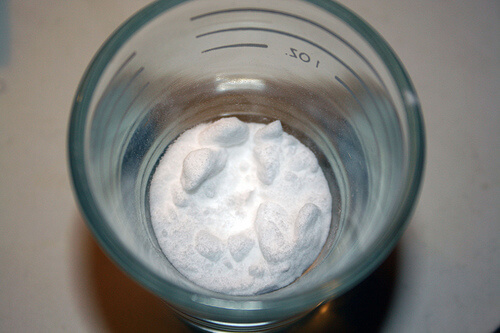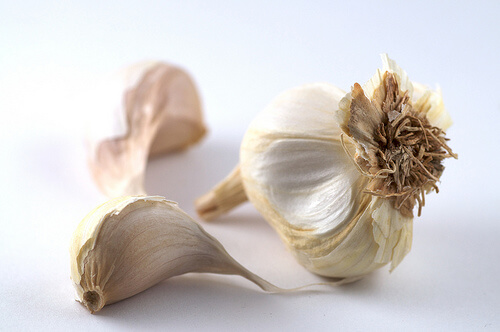Simple Treatments for Vaginal Infections

Lots of women deal with frequent vaginal infections and all the unpleasantness that comes with them. Itching, burning, irritation, altered urination, and many other things. These affect not just their daily lives, but also their intimate relationships. In this article, we’re going to show you some natural, homemade treatments for vaginal infections to help you deal with them.
A pinch of baking soda: one of the treatments for vaginal infections
When you have an infection, it alters the pH levels in the vagina, making it more acidic than usual. A good way to bring it back to normal is to apply a pinch of baking soda directly on the labia. This helps prevent the spread of harmful bacteria and fungi.
It’s also worth remembering that you shouldn’t wash this part of your body with conventional soaps or gels. They can alter the pH levels too. Instead, use organic, natural soaps made with glycerin or coconut oil. Or, just mix a little baking soda into some hot water.

Garlic
Garlic is one of the best treatments for vaginal infections because it’s great at fighting fungi and parasites, which we’ve talked about in a lot of other articles. You can boost your defenses against infection by eating garlic, but there’s also another, more direct way to use it to fight off vaginal infections.
Prick a clove of raw, peeled garlic with a fork or a toothpick to draw out its nutrients. Then insert the clove directly into your vagina. You can wrap the clove in sterile gauze that will absorb the oil, and if you let it stick out some, you can use it to make the garlic easier to remove.
You might like: What are the Health Benefits of Garlic?
It’s best to do this treatment at night before bed, three nights in a row.

Vaginal rinses
Vaginal rinses are done with the help of a bulb or syringe made of silicone, similar to the ones doctors use for intestinal enemas. You draw the liquid up into the bulb and insert the other end into the vagina, so that that liquid flows in when you squeeze the bulb.
Hold it in for a few minutes, and then expel it into the toilet.
Vaginal rinses should always be done with warm or room temperature water.
What can you use in a rinse?
- Thyme: Thyme is a medicinal plant you can use to fight all kinds of infections. Its antiseptic properties help to disinfect any part of the body without altering the pH. Make a fairly concentrated solution if you do this treatment.
- Yogurt and salt water: Combining these two makes for an excellent natural medicine. Yogurt helps promote healthy vaginal flora, and salt water restores the body’s pH and adds minerals. Make a mixture of 50% plain yogurt and 50% salt water, ensuring that it’s well blended.
- Unpasteurized apple cider vinegar: Vinegar is an age-old remedy for women, thanks to its low price and easy availability. It not only helps fight pathogens, but also promotes healthy vaginal flora. Still, you should always choose fermented “live”, unpasteurized vinegar, even though it’s not as easy to find nowadays. Mix two tablespoons of vinegar per quart of water.
- Supplement bacterial flora (Lactobacillus), which you usually have to take orally. You can also empty the capsules into some water and use that as a rinse. This is a much more direct tactic.
Read more: Apple Cider Vinegar, Ginger, and Honey Digestive Tonic
Other tips on treatments for vaginal infections
As always, if you want to solve a health problem naturally you’ll attack it from different angles: watching your diet, avoiding bad habits, and following a clear treatment regimen – medically supervised, if necessary. For vaginal infections it’s especially important to eliminate refined sugars and flours from your diet. You can also take evening primrose oil and borage in capsule form: they provide omega-6, an extremely beneficial fatty acid.
All cited sources were thoroughly reviewed by our team to ensure their quality, reliability, currency, and validity. The bibliography of this article was considered reliable and of academic or scientific accuracy.
- Abbe, C., & Mitchell, C. M. (2023). Bacterial vaginosis: a review of approaches to treatment and prevention. Frontiers in Reproductive Health, 5, 1100029. https://www.ncbi.nlm.nih.gov/pmc/articles/PMC10264601/
- Ahangari, F., Farshbaf-Khalili, A., Javadzadeh, Y., Adibpour, M., & Sadeghzadeh Oskouei, B. (2019). Comparing the effectiveness of Salvia officinalis, clotrimazole and their combination on vulvovaginal candidiasis: A randomized, controlled clinical trial. The Journal of Obstetrics and Gynaecology Research, 45(4), 897–907. https://pubmed.ncbi.nlm.nih.gov/30663184/
- Almeida, K., Silva, L., Silva, G., Silva-Neto, C., Prado, R. (2015). Atividade Inibitoria de Handroanthus serratifolius (Bignoniaceae) sobre Candida albicans. Revista Eletrônica da Faculdade de Ceres 4(2), 1 https://www.researchgate.net/publication/305115612_ATIVIDADE_INIBITORIA_DE_Handroanthus_serratifolius_Bignoniaceae_SOBRE_Candida_albicans
- Arcila, L, C., Loarca, P. G., Lecona, U. S., & González, M. E. (2004). El orégano: propiedades, composición y actividad biológica de sus componentes. Archivos Latinoamericanos de Nutrición, 54(1), 100-111. http://ve.scielo.org/scielo.php?script=sci_arttext&pid=S0004-06222004000100015&lng=es&tlng=es
- Cleff, M. B., Wendisch, I., Cabana, A. L., Rodrigues, M. R., Mello, J. D., Meireles, M. C. A., & Hernández-Escareño, J. J. (2011). Experimental vaginal candidiasis: assessment of Origanum vulgare for its treatment. https://academic.oup.com/jambio/article-abstract/122/5/1177/6714580
- Di Vito, M., Mattarelli, P., Modesto, M., Girolamo, A., Ballardini, M., Tamburro, A., Meledandri, M., & Mondello, F. (2015). In Vitro Activity of Tea Tree Oil Vaginal Suppositories against Candida spp. and Probiotic Vaginal Microbiota. Phytotherapy Research, 29(10), 1628–1633. https://pubmed.ncbi.nlm.nih.gov/26235937/
- Fernández, M., Lombardía, J. (2002). Vulvovaginitis y cervicitis en la práctica diaria. Medicina de Familia SEMERGEN, 28(01), 15-20. https://www.elsevier.es/es-revista-medicina-familia-semergen-40-articulo-vulvovaginitis-cervicitis-practica-diaria-13025456
- Fouladi, Z., Afshari, P., Gharibi, T., & Dabbagh, M. A. (2009). The comparison oF Zataria multiflora boiss (Avishan Shirazi) and Clotrimazol vaginal cream in the treatment of candidiasis vaginitis. Iranian South Medical Journal, 12(3), 214-224. https://ismj.bpums.ac.ir/browse.php?a_code=A-10-3-173&sid=1&slc_lang=en
- Genet, J. (1995). Remedios naturales para infecciones vaginales [Natural remedies for vaginal infections]. SIDAhora, 40–41. https://pubmed.ncbi.nlm.nih.gov/11362438/
- Karaman, M., Bogavac, M., Radovanović, B., Sudji, J., Tešanović, K., & Janjušević, L. (2017). Origanum vulgare essential oil affects pathogens causing vaginal infections. Journal of Applied Microbiology, 122(5), 1177-1185. https://academic.oup.com/jambio/article/122/5/1177/6714580
- Kumar, N., Behera, B., Sagiri, S. S., Pal, K., Ray, S. S., & Roy, S. (2011). Bacterial vaginosis: Etiology and modalities of treatment-A brief note. Journal of Pharmacy & Bioallied Sciences, 3(4), 496–503. https://pubmed.ncbi.nlm.nih.gov/22219582/
- López, T. (2006). Tomillo. Offarm, 25(01), 74-77. https://www.elsevier.es/es-revista-offarm-4-articulo-tomillo-13083626
- Mohammadzadeh, F., Dolatian, M., Jorjani, M., Alavi Majd, H., & Borumandnia, N. (2014). Comparing the therapeutic effects of garlic tablet and oral metronidazole on bacterial vaginosis: a randomized controlled clinical trial. Iranian Red Crescent Medical Journal, 16(7), 19118. https://pubmed.ncbi.nlm.nih.gov/25237588/
- Mohaddese, M. (2018). Systematic review: The potency of Zataria multiflora Boiss in treatment of vaginal infections. Infectio, 22(02). http://www.scielo.org.co/scielo.php?pid=S0123-93922018000200076&script=sci_arttext
- Patole, V., Mahore, J., Nandgude, T., Gutte, A. (2022). Apple cider vinegar: Effective adjuvant treatment for aerobic vaginitis. Novel Research in Microbiology Journal, 6(04), 1659-1669. https://journals.ekb.eg/article_253697.html.
- Ogbolu, D. O., Oni, A. A., Daini, O. A., & Oloko, A. P. (2007). In vitro antimicrobial properties of coconut oil on Candida species in Ibadan, Nigeria. Journal of Medicinal Food, 10(2), 384–387. https://pubmed.ncbi.nlm.nih.gov/17651080/
- Ozen, B., Baser, M. (2017). Vaginal Candidiasis Infection Treated Using Apple Cider Vinegar: A Case Report. Alternative Therapies in Health & Medicine, 23(07), 260. https://openurl.ebsco.com/EPDB%3Agcd%3A6%3A9770646/detailv2?sid=ebsco%3Aplink%3Ascholar&id=ebsco%3Agcd%3A127117853&crl=c
- Shiravani, Z., Poordast, T., Alamdarloo, S. M., Najib, F. S., Hosseinzadeh, F., & Shahraki, H. R. (2021). Chamomile Extract versus Clotrimazole Vaginal Cream in Treatment of Vulvovaginal Candidiasis: A Randomized Double-Blind Control Trial. Journal of Pharmacopuncture, 24(4), 191–195. https://pubmed.ncbi.nlm.nih.gov/35028170/
- van de Wijgert, J., & Verwijs, M. C. (2020). Lactobacilli-containing vaginal probiotics to cure or prevent bacterial or fungal vaginal dysbiosis: a systematic review and recommendations for future trial designs. BJOG, 127(2), 287–299. https://pubmed.ncbi.nlm.nih.gov/31299136/
- Ventolini, G., Gandhi, K., Manales, N., Garza, J., Sanchez, A., Martinez, B. (2022). Challenging Vaginal Discharge, Lactobacillosis and Cytolytic Vaginitis. Journal of Family Reprod Health, 16(2), 102-105. https://jfrh.tums.ac.ir/index.php/jfrh/article/view/1964
This text is provided for informational purposes only and does not replace consultation with a professional. If in doubt, consult your specialist.








